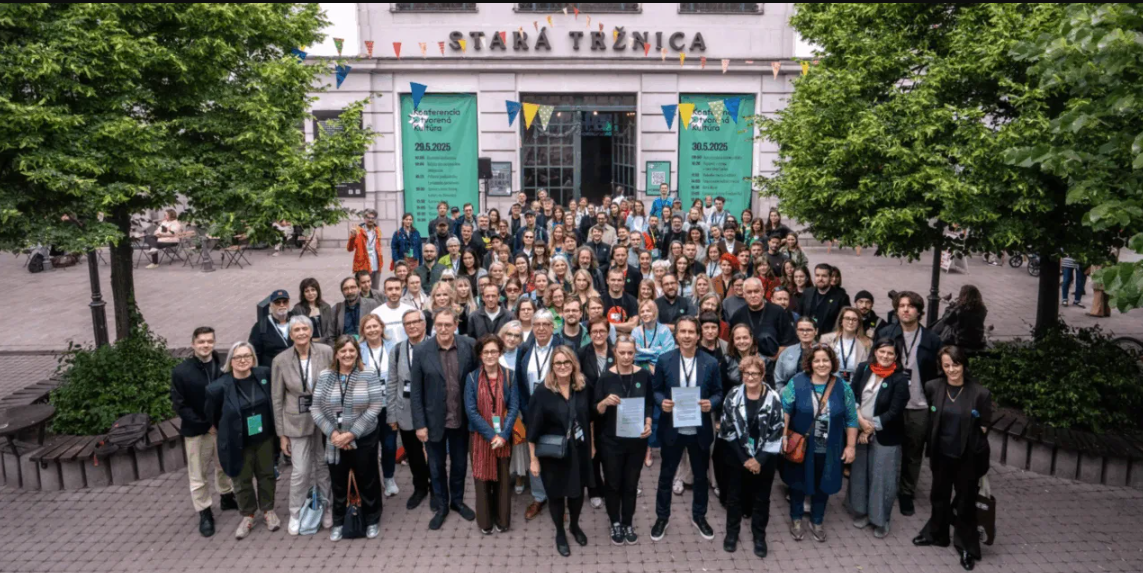see: https://cultureactioneurope.org/advocacy/resistance-now-together-updates/
When the Slovak government fired Matej Drlička from his post as Director General of the Slovak National Theatre in August 2024, it was meant to be just another quiet purge of a cultural leader who had fallen out of political favour. Instead, it sparked a continental uprising.
Under the banner “Resistance Now Together,” over 200 cultural institutions across 50 countries have united in an unprecedented campaign to protect artistic freedom from what they see as a rising tide of authoritarianism sweeping across Europe.
The initiative began with the RESISTANCE NOW! Campaign from Vienna, which organized a 16-city tour spanning from Stockholm to Belgrade, New York to Taipei. Through artistic actions, political interventions, and public debates, the campaign reached an estimated 100 million people—a staggering figure that caught the attention of both cultural leaders and politicians across Europe.
By April 2025, the movement had evolved into something more structured and ambitious. At the National Theatre of Greece in Athens, representatives from over 70 European theaters signed the RESISTANCE NOW TOGETHER Manifesto, committing their institutions to three core principles: resist political interference, program diverse work that connects communities, and foster cross-border partnerships.
The manifesto reads like a declaration of war against cultural censorship. “We oppose trends toward division, censorship, and political interference in cultural autonomy,” it states, calling on world leaders to uphold democracy, equality, freedom of speech, and cultural freedom.
But manifestos alone don't stop governments from meddling in the arts. The movement's most ambitious goal is the creation of a European Culture Freedom Act—legislation that would protect artistic freedom across all EU member states, similar to existing media freedom laws.
"We have now joined forces with key international partners to advance our goal of launching a binding European Artistic Freedom Act (EAFA) at the EU level, ensuring consistent protection of artistic freedom across all Member States" reads the latest announcement by CAE.
The movement's steering group, including the Artistic Freedom Initiative and Culture Action Europe, is working with EU institutions to draft the proposed European Culture Freedom Act by the end of 2025. They're also maintaining direct dialogue with European Parliament members and Commission representatives, pushing for concrete legislative action.
"Together with legal experts from the Artistic Freedom Initiative (AFI) and the Secretary General of Culture Action Europe we have formed a steering group with the aim of having a first draft of the new law ready by the end of 2025."
Background
The campaign gained momentum with an open letter to the European Parliament in winter 2024, published in 26 countries and reaching 100 million readers. The letter, signed by over 200 cultural institutions, demanded explicit legal protection for cultural autonomy.
In May 2025, the movement achieved another milestone with the Bratislava Declaration—a pointed choice of location given that the Slovak dismissal had catalyzed the entire movement. Adopted during the Open Culture! International Conference, the declaration was signed by major networks including NEMO (Network of European Museum Organisations), REMA (European Network of Music Information Centers), and the European Alliance of Academies.
The movement hasn't been without casualties either. In September 2025, Rau became a target when former Austrian Vice-Chancellor Heinz-Christian Strache successfully sued over Rau's book “Resistance Has No Form, Resistance Is the Form,” which examined links between right-wing politics and artistic censorship.
A Vienna court fined Rau's publisher €1,500 for defamation, forcing the book's withdrawal from sale. Rau sees the verdict as proof of their thesis—that right-wing parties are weaponizing legal systems to silence critics. Strache has promised more legal action against Rau personally.
“This is exactly what we're fighting against,” Rau said at a press conference at Berlin's Schaubühne theater the day after the verdict. “They're using the courts to do what they can't do politically—silence artistic voices.”
Stakes Couldn't Be Higher
For Europe's cultural sector, this isn't just about protecting jobs or funding—though budget cuts and dismissals are certainly part of the threat. It's about preserving culture's role as a space for democratic dialogue and dissent.
The movement's participants point to a pattern across Europe: cultural leaders dismissed for programming that challenges political narratives, funding withdrawn from institutions that host controversial works, and increasing pressure on artists to self-censor or face consequences.
From Hungary's takeover of cultural institutions to Poland's previous government's attacks on LGBTQ+ themed exhibitions, from funding cuts in the Netherlands to political interference in Germany's documenta, the examples multiply. Each incident alone might seem isolated, but together they paint a picture of systematic pressure on cultural freedom.
What Comes Next
As of September 2025, Resistance Now Together shows no signs of slowing. With hundreds of cultural organisations now part of the network and legislative proposals moving through EU channels, the movement has achieved a level of unity and political engagement unprecedented in Europe's cultural sector.
The real test will come in translating this energy into concrete legal protections. The proposed European Culture Freedom Act faces a complex path through EU institutions, and even if passed, enforcement in member states hostile to cultural autonomy will be challenging.
Yet the movement has already achieved something remarkable: In an era when democratic norms are under pressure across the continent, theaters, museums, and cultural centers are emerging as defenders of European values.
“Art has always been political,” Rau notes. “The difference now is that politics has come to art. We have no choice but to resist—now, and together.”








